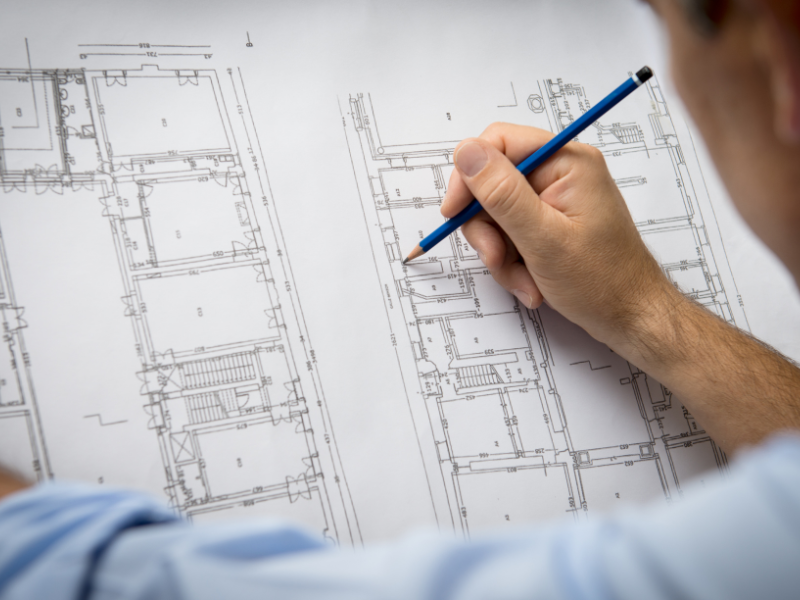Architect Collaboration Tips for Working with Consultants and Project Managers
Architect Collaboration Tips for Working with Consultants and Project Managers
Blog Article
Comprehending the Diverse Profession Paths Available for Aspiring Architect
As a hopeful Architect, you have a globe of job courses waiting for you. Each course offers distinct challenges and possibilities to apply your creativity and technological knowledge. Whether you're attracted to conventional style or the nuances of sustainable style, there's a specific niche that aligns with your passions. Comprehending these diverse choices can form your expert journey, yet which direction will you pick to discover initially?
Standard Architecture: Creating Frameworks and buildings
Typical design focuses on creating buildings and frameworks that mix functionality with aesthetic allure. As you discover this field, you'll appreciate the intricate balance between form and objective. You'll learn to draw inspiration from historical styles, integrating components like proportion, products, and workmanship. Your designs can reflect cultural heritage, showcasing regional customs while fulfilling modern requirements.
You'll establish skills in preparing, model-making, and site analysis, permitting you to visualize and interact your ideas properly. Engaging with clients, you'll require to comprehend their vision and convert it into practical designs.
Moreover, developing codes and sustainability methods are essential in your job, guaranteeing your frameworks are risk-free and ecologically friendly. As you grow in your career, you'll locate possibilities in property, industrial, and even remediation projects, each offering unique difficulties. Accepting conventional design leads the way for a meeting career that pays tribute to the past while forming the future.
Urban Preparation: Forming Neighborhoods and Public Spaces
As an aspiring Architect, you can play a crucial function as an urban organizer, transforming just how neighborhoods communicate and operate. By utilizing area interaction strategies, you'll ensure that residents have a voice fit their environment. And also, incorporating sustainable layout principles will certainly aid produce rooms that not only meet today's requirements but additionally secure the future.
Function of Urban Planners
While numerous might think about architects as the sole visionaries behind buildings, city coordinators play an important duty fit the wider landscape of communities and public areas. They assess land use, zoning legislations, and community requires to develop sustainable settings that improve top quality of life. By working together with different stakeholders, you'll help design parks, transport systems, and suburbs that promote social communication and ease of access. Urban planners also concentrate on ecological factors to consider, guaranteeing that developments integrate environment-friendly areas and support biodiversity. Your competence in spatial design and neighborhood characteristics enables you to envision future development while protecting cultural heritage. In this important role, you'll directly affect exactly how individuals experience their surroundings, making every project an opportunity for positive change.
Neighborhood Interaction Strategies
Reliable community interaction approaches are vital for metropolitan organizers to guarantee that the voices of locals are listened to and valued in the planning procedure. To foster meaningful dialogue, you must focus on open forums and workshops where neighborhood participants can share their ideas and problems. By actively paying attention and integrating feedback, you'll produce spaces that mirror the community's requirements, eventually leading to even more lasting and effective urban environments.
Sustainable Design Concepts
When creating city rooms, including sustainable style concepts is critical for developing environments that thrive both environmentally and socially. You must start by concentrating on energy effectiveness, making use of products that lower waste and advertise recycling. Think about integrating green spaces, like gardens and parks, to enhance biodiversity and boost air quality. Promoting walkability and public transport can lessen dependence on automobiles, promoting a healthier community.
Creating with water preservation in mind is likewise essential-- consider rain gardens and permeable surfaces to manage stormwater. Entailing community members throughout the preparation procedure guarantees that the spaces you create fulfill their demands and urge social communication. By accepting these principles, you'll add to lively, lasting city landscapes that profit everyone.

Landscape Architecture: Producing Lasting Outside Atmospheres
As you discover landscape architecture, you'll find vital design principles that develop functional and gorgeous outdoor spaces. Lasting techniques play an important function in guaranteeing these environments prosper while reducing ecological impact. And also, you'll discover a variety of career possibilities that allow you to make an actual difference in how individuals communicate with nature.
Design Concepts in Landscape
Understanding design principles in landscape design is essential for creating sustainable outside settings that integrate with nature. You'll require to ponder elements like balance, range, and percentage to ensure your styles feel cohesive and inviting. Additionally, pay attention to seasonal changes, developing with products that match the environments year-round.
Lasting Practices Review
Lasting techniques in landscape architecture not just concentrate on appearances however additionally focus on ecological wellness and source conservation. You can create rooms that website promote soil wellness, such as exercising and using natural products permaculture concepts. Ultimately, these techniques assure your designs benefit both individuals and the setting for years to come.
Career Opportunities Expedition
With a solid structure in lasting techniques, landscape architecture supplies a selection of job paths that permit you to make a meaningful effect on the environment. Urban coordinators usually work together with landscape architects to produce eco-friendly areas in city settings, improving city livability. If you're enthusiastic regarding education, consider ending up being a landscape design instructor, motivating future generations.
Lasting Design: Concentrating On Eco-Friendly Practices
As you discover your job in architecture, embracing environmentally friendly methods can establish you apart in an affordable area. Sustainable layout concentrates on producing buildings that minimize environmental effect while enhancing passenger wellness. By incorporating eco-friendly materials, energy-efficient systems, and sustainable building methods, you'll add to a greener future.
Start by gaining expertise of green qualifications like LEED or BREEAM, more info which can reinforce your credentials. Think about exactly how all-natural light, air flow, and thermal performance can enhance design. Work together with engineers and ecological professionals to innovate solutions that lower waste and conserve sources.
Don't neglect the relevance of area participation-- appealing regional stakeholders can motivate styles that harmonize with the setting. As customers increasingly focus on sustainability, your experience in eco-friendly methods will certainly not just attract projects however additionally accomplish your passion for accountable style. Embrace this vital element of the career, and view your occupation thrive.
Historic Conservation: Protecting and Bring Back Social Heritage
While you begin on your architectural trip, think about the vital role of historical conservation in keeping our social heritage. This area concentrates on the defense and remediation of substantial structures, sites, and frameworks that tell the tales of our past. By taking part in historic preservation, you'll help secure the architectural tradition that shapes community identification.
As a historical conservation Architect, you'll examine historic value and assess the problem of structures. You'll work very closely with guardians and chroniclers to ensure genuine restoration techniques are employed. This profession course allows you to mix creativity with research, enabling you to create solutions that respect initial materials and workmanship.
Your job not just contributes to sustainability by reusing existing buildings but likewise promotes a feeling of pride within communities. Accepting this path will certainly aid you end up being a guardian of background, protecting the tales and aesthetics that improve our lives.
Interior Style: Enhancing Indoor Spaces
Historical conservation and interior design both share a dedication to enhancing the built website setting, yet they concentrate on different elements. While historical preservation highlights preserving a structure's historic and cultural value, interior design nos in on enhancing interior spaces for performance and aesthetic appeals.
As a hopeful Architect, you'll discover that indoor style enables you to mix creative thinking with technological abilities. You'll design spaces that not only look excellent however additionally promote comfort and effectiveness. This field entails comprehending exactly how light, shade, and products interact within a room, affecting mood and functionality.
You'll service numerous projects, from residential homes to commercial workplaces, guaranteeing that each setting satisfies the demands of its residents. By prioritizing user experience, you can change interiors into useful and inspiring rooms, making a substantial effect on exactly how people connect with their environments. Welcome the opportunity to improve interior settings and shape the method people work and live.
Industrial Design: Merging Performance With Appearances
Industrial design plays an important duty in developing products that flawlessly blend aesthetics with capability, making sure that what you make use of everyday is not only aesthetically enticing but also useful. As a hopeful Architect, you can engage on your own in this area, focusing on creating everything from furnishings to customer electronic devices. Your work includes comprehending customer demands, products, and making processes, enabling you to develop cutting-edge remedies that improve daily experiences.
In commercial style, you'll usually work together with suppliers, designers, and marketers, making sure that your layouts are not just gorgeous but also practical. This profession path uses a vibrant setting where imagination fulfills usefulness, making it a satisfying option for designers interested in shaping the products of tomorrow.
Often Asked Questions
What Educational Accreditations Do I Required to Come To Be a Designer?
To become an engineer, you'll require a professional degree in style, usually a Bachelor's or Master's. Additionally, you'll have to complete an internship and pass the Architect Enrollment Examination to practice lawfully.
Are There Certification Needs for Different Architectural Profession Paths?
Yes, there're accreditation demands for numerous architectural courses. Architect. You'll require to pass exams, total teaching fellowships, and often seek specialized training, relying on your picked focus, like landscape style, metropolitan design, or historical preservation
What Software Program Abilities Are Crucial for Architects Today?

How Can I Gain Practical Experience While Studying Architecture?
You can gain sensible experience by interning at architectural firms, joining style competitions, volunteering for area projects, or working together with classmates on real-world tasks. These chances enhance your skills and construct valuable connections in the market.
What Task Opportunities Exist Outdoors Standard Architecture Firms?
You can discover various work possibilities outside typical design firms, like urban planning, interior decoration, landscape design, building and construction administration, property growth, or perhaps roles in sustainability consulting. Each deals special challenges and rewards.
Whether you're attracted to typical design or the subtleties of lasting design, there's a particular niche that aligns with your passions.When making metropolitan rooms, including lasting layout principles is important for producing environments that thrive both ecologically and socially.As you discover landscape style, you'll discover vital layout principles that produce useful and gorgeous exterior spaces.Understanding style concepts in landscape design is vital for developing sustainable outdoor settings that integrate with nature.In commercial style, you'll commonly collaborate with designers, suppliers, and marketing professionals, making certain that your layouts are not just beautiful however also practical.
Report this page